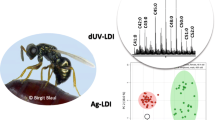Abstract
Cuticular hydrocarbons from tiny pieces of insect cuticle can be analyzed directly by gas chromatography without solvent. The cuticle, sealed in a glass capillary, is introduced into the heated injector area of a gas Chromatograph, and the glass capillary crushed after heating for 4 min. Linked gas chromatography-mass spectrometry can be performed on selected parts of individual insects, such as an antenna, leg, or abdominal sclerite, to give qualitative and quantitative analysis of the substances on a small area of the body.
Similar content being viewed by others
References
Attygalle, A.B., Herrig, M., Vostrowsky, O., andBestmann, H.J. 1987. Technique for injecting intact glands for analysis of sex pheromones of Lepidoptera by capillary gas chromatography.J. Chem. Ecol. 13:1299–1311.
Attygalle, A.B., Billen, J.P.J., Jackson, B.D., andMorgan, E.D. 1990. Morphology and chemical contents of Dufour glands ofPseudomyrmex ants (Hymenoptera: Formicidae).Z. Naturforsch. 45c: 691–697.
Bagnères, A.G., andMorgan, E.D. 1990. The postpharyngeal glands and the cuticle of Formicidae contain the same characteristic hydrocarbons.Experientia 46:In press.
Bagnères, A.G.,Errard, C.,Mulheim, C.,Joulie, C., andLange, C. 1990. Modification in cuticular hydrocarbons of two ant speciesFormica selysi (Formicinae) andManica rubida (Myrmicinae) reared in mixed colonies. Submitted.
Blomquist, G.J., Nelson, D.R., andDe Renobales, M. 1987. Chemistry, Biochemistry and Physiology of insect cuticular lipids.Arch. Insect Biochem. Physiol. 6:227–265.
Bonavita-Couoourdan, A., Clément, J.L., andLange, C. 1987. Nestmate recognition: The role of cuticular hydrocarbons in the antCamponotus vagus.Scop. J. Entomol. Sci. 22:1–10.
Brill, J.H., andBertsch, W. 1985. A novel micro-technique for the analysis of the cuticular hydrocarbons of insects.Insect Biochem. 15:49–53.
Carlson, D.A., andService, M.W. 1980. Identification of mosquitoes ofAnopheles gambiae species complex A and B by analysis of cuticular components.Science. 207:1089–1091.
Clément, J.L. 1982. Signaux de contact responsables de l'agression interspécifique des termites de genreReticulitermes.C. R. Acad. Sci. Fr. 294:635–637.
Hadley, N.F., Blomquist, G.J., andLanham, U.N. 1981. Cuticular hydrocarbons of four species of Colorado Hymenoptera.Insect Biochem. 11:113–177.
Haverty, M.I., Page, M., Nelson, L.J., andBlomquist, G.J. 1988. Cuticular hydrocarbons of dampwood termites,Zootermopsis: Intra and intercolonial variation and potential as taxonomic characters.J. Chem. Ecol. 14:1035–1058.
Howard, R.W., Mcdaniel, C.A., andBlomquist, G.J. 1982. Chemical mimicry as an integrating mechanism for three termitophiles associated withReticulitermes virginicus (Banks).Psyche 89:157–167.
Jackson, L.L., andBlomquist, G.L. 1976. Insect waxes, pp 201–233, in P.E. Kulatukuddy (ed.). The Chemistry and Biochemistry of Natural Waxes. Elsevier, Amsterdam.
Lockey, K.H. 1978. The adult cuticular hydrocarbons ofTenebrio molitor L. andTenebrio obscurus F. (Coleoptera: Tenebrionidae).Insect Biochem. 8:237–250.
Lockey, K.H. 1982. Hydrocarbons of adultOnymacris plana (Peringuey) andOnymacris rugatipennis (Haag) (Coleoptera: Tenebrionidae).Insect Biochem. 12:69–81.
Lockey, K.H. 1984. Hydrocarbons ofMetriopus depressus (Haag) andRenatiella scrabipennis (Haag) (Coleoptera: Tenebrionidae).Insect Biochem. 14:65–75.
Mintzer, A.C., Williams, H.J., andVinson, S.B. 1987. Identity and variation of hexane soluble cuticular components produced by the acacia antPseudomyrmex ferruginea Comp.Biochem. Physiol. 86B:27–30.
Morgan, E.D., 1990. Preparation of small samples for chromatography of insect pheromones.Anal. Chim. Acta 236:227–235.
Morgan, E.D., andWadhams, L.J. 1972. Gas chromatography of volatile compounds in small samples of biological materials.J, Chromatogr. Sci. 10:528–529.
Trabalon, M., Lange, C., Clément, J.L., andCampan, M. 1988a. Les Hydrocarbures cuticulaires de la femelle deCalliphora vomitoria (Diptères).C. R. Acad. Sci. Fr. 308(III):569–573.
Trabalon, M., Campan, M., Clément, J.L., Thon, B., Lange, C., andLefevre, J. 1988b. Changes in cuticular hydrocarbon composition in relation to age and sexual behaviour in the femaleCalliphora vomitoria (Diptera).Behav. Proc. 17:107–115.
Vienne, C., Bagnères, A.G., Lange, C., andErrard, C. 1990. Etude chimique de la reconnaissance interindividuelle chezMyrmica rubra etMonica rubida (Formicidae: Myrmicinae) élevés en colonies mixte artificielle.Actes Coll. Insect. Soc. 6:261–265.
Author information
Authors and Affiliations
Rights and permissions
About this article
Cite this article
Bagnères, A.G., Morgan, E.D. A simple method for analysis of insect cuticular hydrocarbons. J Chem Ecol 16, 3263–3276 (1990). https://doi.org/10.1007/BF00982097
Received:
Accepted:
Issue Date:
DOI: https://doi.org/10.1007/BF00982097




